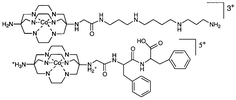Synthesis with coordinated ligands: biomolecule attachment to cage amines
Abstract
Conventional procedures can be used to obtain derivatives of carboxylic acid groups pendent to a cage

a
Special Research Centre for Advanced Mineral and Materials Processing and Chemistry Department, University of Western Australia, Nedlands, WA 6907, Australia
E-mail:
jmh@chem.uwa.edu.au
Conventional procedures can be used to obtain derivatives of carboxylic acid groups pendent to a cage

 Please wait while we load your content...
Something went wrong. Try again?
Please wait while we load your content...
Something went wrong. Try again?
P. S. Donnelly and J. M. Harrowfield, J. Chem. Soc., Dalton Trans., 2002, 906 DOI: 10.1039/B110023H
To request permission to reproduce material from this article, please go to the Copyright Clearance Center request page.
If you are an author contributing to an RSC publication, you do not need to request permission provided correct acknowledgement is given.
If you are the author of this article, you do not need to request permission to reproduce figures and diagrams provided correct acknowledgement is given. If you want to reproduce the whole article in a third-party publication (excluding your thesis/dissertation for which permission is not required) please go to the Copyright Clearance Center request page.
Read more about how to correctly acknowledge RSC content.
 Fetching data from CrossRef.
Fetching data from CrossRef.
This may take some time to load.
Loading related content
